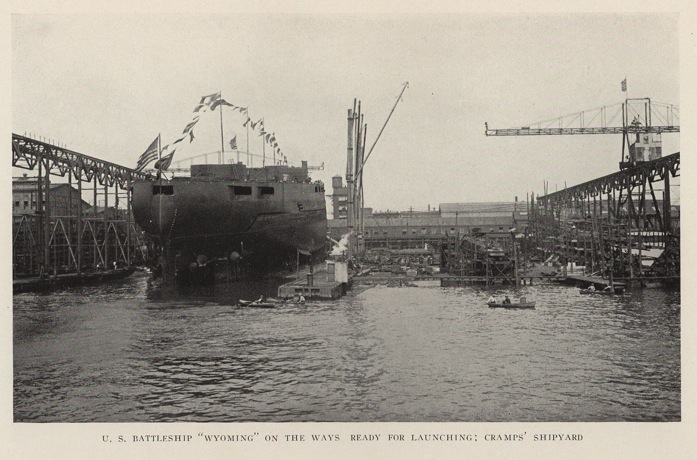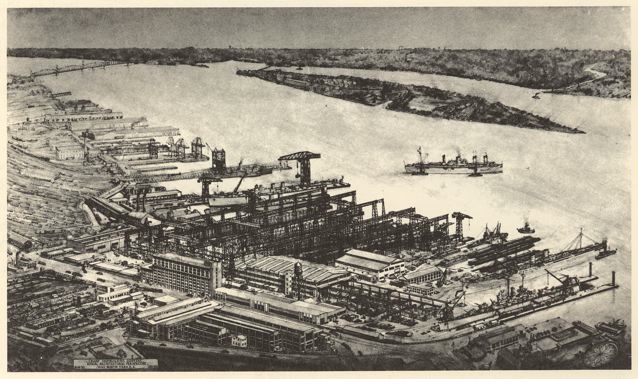
FISHTOWN
© Stuart Paul Dixon,
Workshop of the
World (Oliver Evans Press, 1990).
Though the Fishtown
neighborhood of Philadelphia experienced some European
colonization prior to William Penn's arrival in 1682,
extensive industrial development did not occur until
after the evolution of effective steam power and
intensive settlement. Some marine-related activities,
such as fishing, took place in the early 1700s, although
a primarily agrarian culture existed during the period of
earliest colonization. Since that time, Fishtown,
originally part of Kensington, has evolved into a
distinct, working-class neighborhood bounded by Frankford
Avenue on the west, Norris Street on the northeast, and
the Delaware River to the south and east. A mixed
residential, commercial, and industrial community,
Fishtown today mirrors its evolution from an early
eighteenth-century waterfront village to a dense, urban
neighborhood within Philadelphia.
The Fishtown waterfront did not witness any significant
development and building activity until the 1730s.
Squeezed out of waterfront lots nearer the city because
of rising land values, owners of shipbuilding and repair
facilities began at that time to acquire riverfront lots
north of East Columbia Avenue along the Delaware. As
Fishtown entered the nineteenth century, maritime trades
dominated the community. Occupational listings for
Fishtown residents in city directories show that more
than one-half earned their living as shipbuilders,
shipwrights, ship joiners, ship smiths, and ship
carpenters. Others worked as rope makers, mast makers,
caulkers, wharf builders, carpenters, fishermen, and
blacksmiths. "Shipyards" was printed across the entire
Fishtown waterfront in an 1843 map.
Manufacturing not related to maritime commerce started in
Fishtown in the late eighteenth century. In October 1771,
Robert Towars and Joseph Leacock erected a glass furnace
on the east bank of Gunner's Run (now Dyott Street) along
Bank Street (Richmond Street). Thomas W. Dyott, and later
Henry B. Benners, operated the glass furnace, known as
the Dyottville Glassworks, throughout the nineteenth
century. In 1779, John Hewson, Sr., established a calico
and linen printing factory on land neighboring the glass
furnace. Hewson manufactured gowns and blue handkerchiefs
with white spots.
Extensive industrial manufacturing in Fishtown commenced
in the 1830s, a period when steam power was changing
America's urban spaces and economy. William Cramp started
his shipbuilding business in 1830 at the foot of Otis
Street (now East Susquehanna Avenue). Known as the
William Cramp and Sons Ship and Engine Building Company,
Cramp's business grew into one of the world's largest
manufacturers of iron ships. It was Fishtown's biggest
employer well into the mid-twentieth century.

Aerial
Architecture Perspective of Cramp Shipbuilding Company in
1943 by Adiel Martin Stern, R.A.
Jonathan Wainwright and Samuel Gillingham's steam-powered
sawmill and lumber business started at Beach and Hanover
(East Columbia Avenue) Streets during this period; this
extensive business, later known as Gillingham &
Garrison, survived until the 1940s.
Several other firms established in the first half of the
nineteenth century further illustrate the growing
diversity of Fishtown's industries. In 1838, the Reaney
and Neafie Penn Steam Engine & Boiler Works began
manufacturing steam engines and boilers at the corner of
Beach and Palmer Streets. Reaney and Neafie, later Neafie
and Levy, also made iron boats, propellers, forgings, and
brass and iron castings until the early 1900s.
Bancroft & Sellers began manufacturing machine
tools and mill gearing on Beach Street opposite Penn
Treaty Park in 1848. Bancroft died in 1855, and the firm
became William Sellers & Company. Sellers &
Company was highly regarded for the quality of its teeth
cutting wheels, lathes, planing machines, steam hammers,
and screw stocks and dies.
In the early 1850s, Fishtown began to participate in the
accelerating industrialization of Philadelphia's textile
trades. Martin Landenberger's Hosiery Mill on the corner
of Frankford Avenue and Wildey Street and the Henry
Becker Hosiery Mill on Moyer Street stand as testimony to
this heritage (both companies are documented in this
chapter). Much textile production in Kensington focused
on hand-loom carpet and hosiery weaving. "Outworking," or
domestic manufacture, persisted in Fishtown into the
early 1900s. Domestic manufacturing ranged in size from
S. C. Ridpath & Co.'s 55 hand-looms, with "15 of
these looms at homes of weavers," making 25,000 yards of
carpet per month at 1242 Day Street, 1
to William J.
Crowe's three looms producing 1,500 yards per month at
401 East Girard Avenue. (Crowe's hand-loom manufactory is
documented in this chapter.)
After the Civil War, the markets of the western frontier
helped spur Fishtown's industrial and community growth,
peaking in the period between 1880 and 1900. Among the
businesses that began during this era of industrial
expansion were the Ajax Metal Company and the A. J. Reach
& Co., manufacturers of sporting goods (both
companies are described in this chapter). These concerns
remained in Fishtown until the mid-twentieth century.
Although somewhat unreliable because of enumeration by
districts as opposed to wards, the 1870 industrial census
listed 213 industrial establishments in Fishtown. In
1883, Lorin Blodget described an industrial landscape not
much different from the one that existed 13 years
earlier:
“The
southern and central portions of these wards [the 16th,
17th, 18th, and 20th; Fishtown composed the entire 18th
ward during this period] are densely occupied and almost
exclusively manufacturing, while the Delaware river
front, from Poplar street to Lehigh Avenue, is in part
occupied with lumber and coal yards, with several
shipbuilding establishments and
iron-works.” 2
According to Blodget, Fishtown's larger non textile
industries included three brass and bronze smelters, one
brewery, one alcohol distillery, three furniture
manufacturers, three glass houses, five rolling mills,
two iron shipbuilders, three iron foundries, one wire
works, three saw mills, one sugar refinery, one wharf
builder, and thirteen wrought iron manufacturers.
3
Around the turn of the twentieth century, Fishtown began
to experience a shift to more modern industrial
technologies and processes. In 1911, the American Can
Company, a concern newly formed as a collection of small
can factories, erected a general line manufacturing plant
on the corner of Beach and Palmer Streets. Although
American Can was a leader in developing sanitary cans,
the process of packing foodstuffs in tin cans without
atmospheric leakage leading to spoilage, the Fishtown
plant focused on non- food cans. American Can stopped
production in March 1989.
The advent of effective electrical power and the
subsequent demand for electrical power by industrial and
residential groups gave the Philadelphia Electric Company
the impetus to construct a power-generating station in
Fishtown in 1919. Located on the corner of Beach Street
and East Columbia Avenue, the Delaware Station generating
plant quickly required expansion in 1923. Further demand
for electricity necessitated additional expansion and
construction in 1953.
In 1935, in a former carpet-cleaning complex on East
Columbia Avenue, the Electro-Nite Carbon Company began
manufacturing carbon-graphite brushes for electric
motors. After World War II, Electro-Nite focused on the
production of disposable thermo-couples for use in the
steel industry's electric crucibles. Electro-Nite soon
outgrew its shop on Columbia Avenue and moved to larger
quarters on Torresdale Avenue and Mercator Road.
Electro-Nite's thermo-couples continue to be used
throughout the world, especially in Japan's steel
industry.
A microcosm of the city around it, Fishtown has
experienced the same kind of industrial decline that
effected Philadelphia and other large industrial cities
after the Depression and again after World War II. In the
last half of the twentieth century, the manufacturing
bases of Fishtown and Philadelphia are dramatically
smaller than those of the previous century. However,
Fishtown still has a large number of industrial sites
that reflect its rich and diverse industrial past and the
pattern and extent of its industrial development.
1
Blodget,
Lorin. The
Textile Industries of Philadelphia
(Philadelphia,
1880), p.49.
2 Blodget, Lorin.
Census
of Manufactures of Philadelphia (Philadelphia, 1883), pp.
64-65.
3 Blodget, 1883, pp.
65-75.
Acknowledgements:
Special thanks to
Sara Jane Elk and Carmen A. Weber, for their valuable
help in the neighborhood survey and descriptions of the
sites. Thanks to Jack Steelman, Frank Sullivan, Harold
Spaulding, and Raymond Wyszynski for sharing their
personal knowledge concerning Fishtown industries. Thank
you to the librarians and curators of institutions whose
collections were consulted, especially Jefferson Moak of
the Philadelphia City Archives. A heartfelt thank you to
the residents of Fishtown for sharing their neighborhood
and memories.
Resources:
Fishtown
bibliography